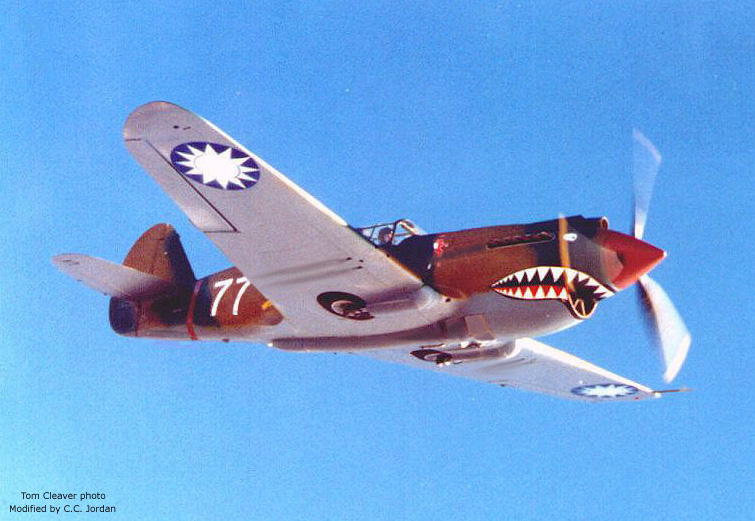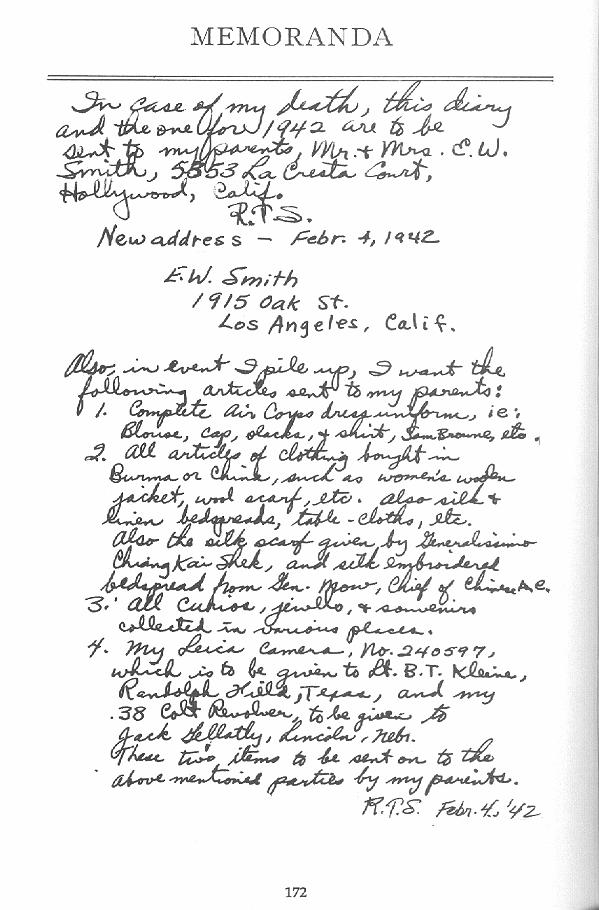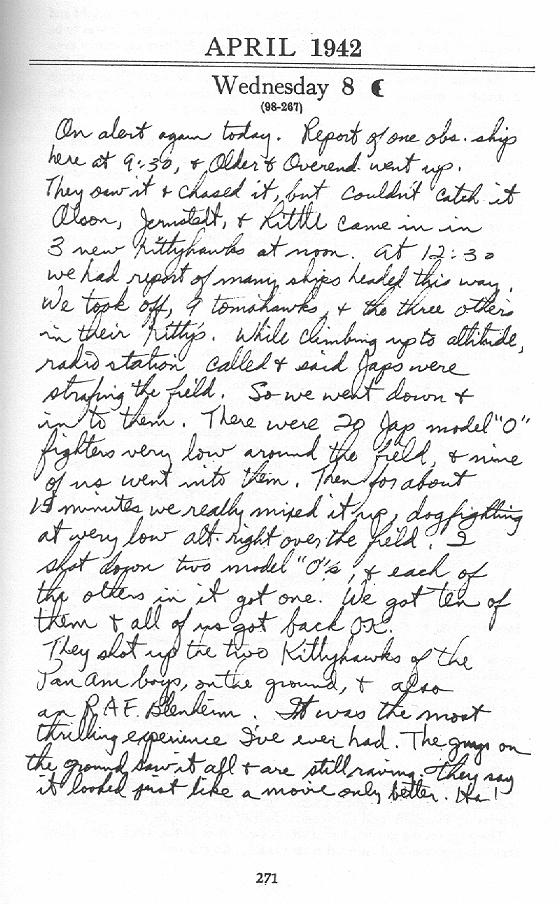
Shop Amazon - Create an Amazon Baby Registry


One of the great problems faced by the pilots of the
AVG was coping with the extended period away from loved ones
and the realization that the possibility of never seeing them
again was a very real consideration.
R.T. Smith came to grips with the possibility of death very much as did every other veteran facing combat. He planned for the worst and made sure that his personal property was sent to his family and friends.
 |
So much has been written since the war about the inherent superiority of the Japanese fighters over the Curtiss P-40. I recently read in Clash of Wings by Walter J. Boyne, that "the most important (Japanese) fighter was the Zero, clearly superior to any American fighter it would meet." Mr. Boyne also states that the AVG was "equipped with obsolete Curtiss P-40s," I must take exception to Mr. Boyne's comments. Nonetheless, Walter Boyne is a retired USAF Colonel and the former director of the Smithsonian's Air and Space Museum. That I have a differing opinion must be weighed in the light of Mr. Boyne's knowledge and status within the community of aviation writers and historians. I, personally, have nothing but the greatest respect for Mr. Boyne. That, however, does not weaken my argument, per se. The record of the AVG and the Curtiss P-40/Tomahawk has withstood the test of time and the best efforts of the Imperial Japanese Army Air Force. Moreover, the men who beat the stuffing out the Japanese with their "obsolete" Tomahawks will march in lock-step with me on this issue. The Curtiss P-40/Tomahawk was not obsolete in comparison to its Japanese adversaries. On the contrary, it was superior to the Japanese fighters in every category that ultimately mattered in 1942.
The P-40B and C were essentially, new aircraft, in service for less than a year. There was nothing "obsolete" about them. What this illustrates is how deep the myth of the Zero's (and Ki-43 Hayabusa) superiority is engrained in aviation history. Nonetheless, much of this is untrue and pilots like R.T. Smith would argue that the P-40 was the better fighter, and they would be correct.
Let's compare the Zero to the P-40B:
1) The P-40 is 20 to 30 mph faster at all atitudes below 20,000 ft.
2) The P-40 has a far higher dive redline and accelerates much
faster in a dive.
3) The Zero was a light weight fighter, incapable of absorbing
battle damage without coming apart or burning. The P-40 could take a
great deal more punishment, had self sealing fuel tanks and could
tolerate the abuse of high G maneuvering.
4) The P-40 had a better and more effective armament than any
comtemporary Japanese fighter.
5) At speeds in excess of 250 mph the P-40 could easily out-roll
the Zero or Oscar and actually turn better as well.
The advantages of the Zero:
1) The Zero (and Oscar) had better low speed turning ability.
2) The Zero (and Oscar) could climb faster.
3) The Japanese fighters, especially the Zero had outstanding
endurance (range).
One can see that the Zero and it's bretheren were only effective if their enemy decided to fight a low speed turning dogfight.
The Zero and its pilot were dependent upon the P-40 pilot fighting to the A6M's strengths. If not, the Zero was at a decided disadvantage. Battles, be they air battles, ground battles or sea battles all hinge on tactics. If your enemy avoids fighting by your terms, you will lose. It's simple really. If the Zero is a great low speed turner, don't get into low speed turning duels. If it climbs well, don't try to get away by climbing.
The superior fighter is not neutralized by tactics, as is the case of the Zero. What tactics could neutralize the P-40? None. The pilot of the faster aircraft sets the rules of engagement. The pilot of the slower fighter has no choice but to accept them and hope the other guy makes a dumb mistake.
Let Erik Shilling explain the tactics used to defeat the nimble Japanese fighters:
"To show a couple examples of attacking enemy fighters:
If you attack head on, which the enemy was reluctant to do, because
our guns outranged theirs, they would normally pull up. (If
he started turning away, he would already be at a disadvantage.)
You started firing at Max range, and then dive away, under these
conditions we didn't turn and tangle with a Jap fighters."
"Attacking the enemy from a 3 to 6 o'clock position."
"Why roll rate was important, is that one must remember that all
maneuvers, except for a loop, started with a roll. The slower the
roll rate the longer it took before the turn began.
1. If he turned away, he set you up on his six. A most undesirable
position for him, because he would be a dead duck.
2. The enemy invariably turned toward you which was normal and anticipated. With his slower roll rate, you could beat him into the turn, get a deflection shot at him, and when you slowed down to where he started gaining on you in the circle, you rolled and dove away before you were in his sights. If you haven't tried it, don't knock it."
"This is where roll rate came into the picture. As far as Japanese fighters were concerned, their inferior roll rate was at all speeds. Above 240, it would take the Zero 3 seconds before he attained bank angle for max turn. (And the airplane doesn't start turning until bank angle is established)."
"Since you could see him starting to bank, which you would have anticipated, you could easily bank more quickly and establish max bank angle within 1 second, and pull whatever "Gs" necessary to establish lead."
"At this speed, and with your lead already established, you could maintain lead for some time before speed bled off to where the Zero could turn inside, you got the hell out (Don't forget, the same speed and same "G" equal same radius of turn). Above 220 IAS the radius of the circle was determined by pilots ability to withstand "Gs." You could turn with the Zero as long as the speed was above 220 IAS.
If his reaction was only to pull. At these speed the "G" factor still applies, beside the Zero could not take 6 "Gs," and the P-40 could pull over 9 "Gs." Most fighter pilots could "momentarily" withstand 9 "G's" or more without blacking out."
"If the situation was reversed and the Zero was attacking you. Your roll rate would save your ass by allowing you to roll to max turning bank, use 6 "Gs" or more, then continue rolling to inverted and dive. Rolling 180 degrees to dive would take less than 2 seconds, the Zero took 6. The Zero would never get a shot. He couldn't get lead, and by the time he was inverted you would already be out of range, gaining speed much more rapidly than the Zero."
"As can be seen from the above illustration, that in the beginning roll rate was the primary factor in starting any maneuver except the loop. After bank angle was established then speed was the primary factor. To escape from a zero, roll rate again became the primary factor then speed."
"Anyone who disagrees with the above has never been in combat, and as far as I know, few books if any bring this out."
R.T. describes a swirling air battle that took place right over an AVG air field. The remarkable thing about this battle is that it took place at tree top level, giving away the P-40s advantage in dive speed. The Tigers battled later model Ki-43 Japanese Army fighters, not the Ki-27 Nate. The references to "Zeros" were not unusual. It was common for Allied pilots to refer to various Japanese fighters as "Zeros" or "Zekes". In general, the Ki-43 Hayabusa (Oscar) displayed greater maneuverability than the A6M2 Zero. It was, however, somewhat slower than its Japanese Navy counterpart.
 |
R.T. tells the story in greater detail:
"This was a most unusual day in a couple of ways. First, it was bright and clear For a change in our little Shangrt-La valley, and secondly it was to be one of the few times that we'd tangle with enemy fighters on nearly even terms; I believe there were only about fifteen Zeros to our even dozen P-40s. As usual, the warning was short, and as usual we were all airborne within a couple of minutes. I led the alert flight of Tomahawks, and Oley and his three Kittys followed moments later. Bob little and Fritz Wolf of the 1st Squadron were with us."
"We headed south in the direction of Lashio, climbing "balls out," as we used to put it, and breathing easier as we reached ten thousand feet. Suddenly our radio operator at Loiwing excitedly reported enemy planes strafing the field, but didn't say how many or what type. I immediately headed back, slanting down now and indicating about 300mph. Soon the field was in sight and I could see Zeros buzzing around like flies and a column of smoke rising from a burning plane. I called the others, told them to spread out, check their gun switches, and pick out individual targets. I fired a short burst to test my guns, and saw Cliff Groh, my wingman, do the same as he eased off to the side."
"What followed was the damndest rat-race imaginable; like it or not, this was to be dogfighting right on the deck, no way to escape by diving away this time. But what made the situation truly unique was that we had everything going for us for a change; speed, altitude, and surprise. Better still, we blasted four or five of them out of the picture on that initial attack, and suddenly we actually outnumbered them."
"I picked a Zero that was just completing a strafing run, apparently unaware that I was behind him. I opened fire at about three hundred yards as he began to pull up, closing rapidly, all six guns working beautifully. I couldn't miss, and the Zero flipped over on its side and dove for the ground, crashing in a ball of flame. I pulled up in a chandelle, still with lots of speed. and turned back toward the field. And then saw a strange sight: a Zero chasing a P40 that was chasing another Zero, like follow-the -leader. I cut across to intercept the last Zero, fired a wild burst at him at too great a range and too much deflection for accuracy, but it scared him off the chase and he pulled away in a steep climbing turn. I was tempted but refused to take the bait, turning away and back to the Field instead."
"I spotted another Zero just starting a strafing run and peeled off after him. By the time I could get within range behind him he'd completed his run and was pulling up in a shallow climb. Just as I was about to open fire he began to roll to the left; I did the same, thinking he was about to turn around in a sharp turn, but instead he kept right on rolling, still straight ahead. By then I was already committed and had to follow his maneuver, nearly inverted when I opened fire and thinking, 'This crazy bastard's doing a victory roll.' Mine was more of a sloppy barrel-roll, and I could see my tracers flying wildly all around him, like the stream from a garden hose held by a slowly circling hand, until I kicked rudder and saw them finding their mark, smoke and flame poured from his engine, and that was that. Sayonara....."
"This sort of thing continued until there were no more Zeros to be seen, a few of them having scooted away safely. I believe our final tally for the day was eleven. Fritz Wolf got a couple, and Oley, Overend, little, Hodges, Donovan, Laughlin, and Groh each chalked up one apiece. The guys on the ground had a worm's eye view of the whole show from their slit-trenches and enjoyed it immensely. So did we."
Perhaps, the myth of the Zero, may someday, be put to rest. Certainly, the men who faced the best planes and pilots of the Japanese Army Air Force defeated them soundly. Moreover, the P-40 continued to defeat the A6M, Ki-43, Ki-44 and Ki-61 well into 1945. R.T. Smith, Erik Shilling and hundreds more like them would never accept the myth.....
Editors note:
There may be a limited number of R.T. Smith's
book, "Tale of a Tiger" available. Some are
signed by the author,
who sadly passed away several years ago. A copy may be obtained by
contacting:
